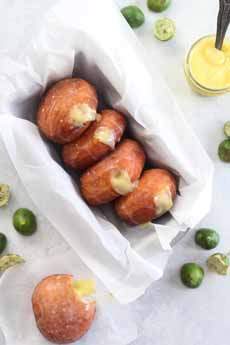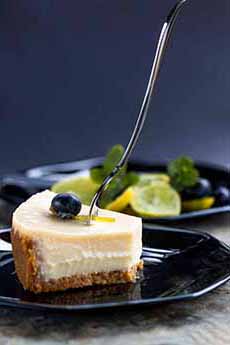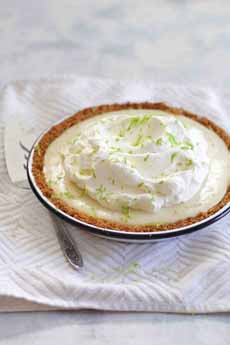RECIPE: Key Lime Donuts For National Key Lime Pie Day
|
|
September 26th is National Key Lime Pie Day, but we wanted to give you a few days’ notice to make this memorable recipe. You’ll find the history of Key Lime Pie href=”#description”>below. But leading off the day this year is a cousin of Key Lime Pie: Key Lime Donuts, created by The Baker Chick (photos #1 and #2). Don’t want donuts? Try this Key Lime Pot De Crème recipe—the same delicious filling without the crust. The Key lime (Citrus aurantifolia Swingle), also known as the Mexican lime and West Indies lime, is grown grown in the Florida Keys (plus Mexico and the West Indies, in case that isn’t apparent). It’s much smaller than the standard supermarket lime known as the Persian or Tahitian lime (Citrus latifolia). Key limes have thin skins and initially, yellow flesh (as to Persian limes, which look like lemons before they ripen). When Key limes ripen to green, the juice is sweeter than Persian limes. While each variety of a species has a unique flavor, the Key lime is tart rather than sour. It has more acidity, but a milder quality than Persian limes. (Here are the different types of limes.) How about some Key lime donuts, freshly fried and filled with key lime custard? This recipe, from The Baker Chick, is as delicious as her other recipes (sign up to get all of them). If you can’t find Key limes, use regular limes rather than bottled lime juice (including bottled Key lime juice—it just doesn’t have fresh flavor). Ingredients For 24 Donuts For The Dough You can make the curd (steps 6 and 7) several days in advance. 1. MAKE the donuts. Warm the milk and combine it with the yeast, stirring lightly. Let it sit for 5 minutes or until it foams up a bit. 2. COMBINE the eggs, melted butter, sugar and milk mixture in the bowl of a stand mixer fitted with a paddle attachment. Mix on medium-high speed until well combined and smooth. 3. ADD the nutmeg, salt and 2 cups of the flour and mix until combined. Then switch to the dough hook attachment. Add the remaining flour and mix until the dough pulls away from the bowl. If the dough feels sticky, add more flour, 1-2 tablespoons at a time, until soft and smooth. 4. OIL a bowl and the place dough inside. Cover loosely and allow to proof (rise) in a warm place for an hour, or until doubled in size. When dough has completed the first proof, punch it down a bit and roll to ½ inch thick. Cut out desired donut shapes. For filled donuts, use a 3.5 inch diameter biscuit cutter and then punch holes out with a large piping tip for regular donuts. You can re-roll the scraps, but try not to overwork the dough and let it rest for a few minutes between rounds, to let it puff up a little bit. 5. PLACE the cut donuts on a lined cookie sheet an inch or so apart and cover loosely again, proofing in a warm place for another 45-60 minutes. While the donuts are proofing, make the filling and glaze. 6. MAKE the curd: Combine the sugar, eggs, zest and juice in a small saucepan. Heat on medium-high and stir constantly, until the mixture becomes thick and coats the back of the spoon—about 10 minutes. 7. REMOVE from the heat, add the butter and stir until smooth. Pour into a heat-safe bowl or jar and pop it into the fridge until ready to use. 8. MAKE the glaze: Whisk together the powdered sugar, vanilla and milk, using more or less depending on how thick you like it. If it gets too thick or hard before you’re ready to use it, whisk it rapidly to smooth it out. 9. FRY the donuts: Heat the oil in a dutch oven or heavy bottomed pan. Clip on a candy thermometer if you have one, and adjust the heat until the oil reaches between 370°F. While the oil is heating, prep some plates or cookie sheets with paper towels on which to drain the fried donuts. When the oil is ready… 10. SLIDE a donut into the oil using a spatula. Fry one at a time until you get the hang of it. When the bottoms are deep golden (45 seconds or so,) use a slotted spoon to flip the donut and fry the other side. Place the finished donuts on the paper towel-lined plates and continue to fry the rest. When the donuts are cool enough to handle… 11. FILL a pastry bag with the curd. USE a chopstick to make a little hole in one end of each donut and add the filling. Dip the top into the glaze and let it dry on a wire rack. Repeat until all donuts are filled and glazed. |
|
|
THE HISTORY OF KEY LIME PIE There are two principal lime types in American supermarkets: the Persian or Tahitian lime, which is what Americans think of as “lime,” and the Key lime, which originated in southern Asia. (Here are the many different types of limes.) After centuries of travel beyond its Asian origin, the Key lime ended up in the Caribbean, including the Florida Keys, for which it is named. The Key lime has a higher acidity, a stronger aroma, and a thinner rind than the Persian lime, and is tart rather than sour. That makes the juice sweeter than Persian limes, and just right for desserts. The peak season for Key limes from Florida is June through August, but they are available year-round from Mexico and Central America. For those who live in the Florida Keys or are otherwise a Key Lime pie connoisseur, only the limes grown in the Keys are acceptable as “Key limes.” If you’ve only had Key lime pie made with bottled lime juice…well, you know the superior, vivid flavor of fresh lime or lemon juice versus bottled juice. You can use Key lime juice in any recipe that calls for conventional lime juice. Try it with olive oil on a salad, substituting Key lime juice for vinegar. Squeeze it into a cocktail. Serve a wedge with seafood, or anyplace you use a lemon or lime wedge. Use it instead of conventional lime juice to give ceviche a lift. If you have an ice cream machine, Key live sorbet is a must-try. The First Key Lime Pie One of the most popular recipes is Key Lime Pie, a lime-flavored custard pie that was created in Key West. It is made with a graham cracker crust. There were no cattle in the Florida Keys, and canned milk, first marketed by Borden’s in 1859, was used instead. We don’t know when or by whom the first Key Lime Pie was baked, but it could not have been before then. The original Key lime pie was a no-bake pie; the acid from the lime juice curdled and set the egg yolks. Today, Key lime pie is the state pie of Florida and the official dessert of Key West, where there are variations of the recipe, including those with meringue topping and/or a pastry crust (believed to be the original crust)—plus a lively debate as to which is the “correct” form of the pie. While Key limes seem more rare today, they were grown commercially in southern Florida until they were wiped out in a 1926 hurricane. The growers replanted with Persian lime trees. Persian limes are hardier, thicker-skinned and easier to pick (no thorns!) and ship. But, they lack the natural sweetness (due to lower acidity) of Key limes. Authentic Key Lime Pie has a firm custard texture and a pale yellow color. Any pie with green custard uses food color and (probably) reconstituted lime juice. Many people use bottled Key lime juice; but as with anything, the difference between bottled and fresh-squeezed juice is the difference between an O.K. versus a spectacular pie. The good news is that, you can squeeze the juice and freeze it for up to three months. Until next Key lime season, you can substitute Persian limes in this recipe (but the flavor of Key limes is more bright and special, which is why people pay more for them). *A candy thermometer is ideal, but any instant read cooking thermometer will work. When the oil is too cool, the donuts may end up greasy and oily. The Baker Chick finds 370°F to be the sweet spot. |
||







